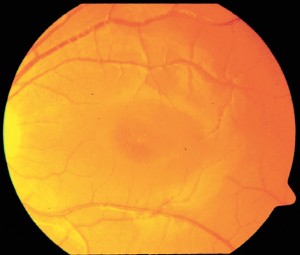By Lauren R. Rosecan, M.D., Ph.D., F.A.C.S.
 Stargardt disease is the most common form of inherited juvenile macular degeneration.
Stargardt disease is the most common form of inherited juvenile macular degeneration.
The progressive vision loss associated with Stargardt disease is caused by the death of specialized, light-sensitive photoreceptor cells in the central portion of the retina called the macula. The retina is the layer of tissue lining the back of the eye, and the macula is the part of the retina that is responsible for your central vision, allowing you to see fine details clearly.
Who Is At Risk for Stargardt disease?
Stargardt disease is almost always the result of a genetic defect. The gene that causes the disease is recessive, meaning it has to be inherited by both parents in order for the disease to appear. Someone who inherits the gene from only one parent will be a carrier for Stargardt disease but will not have any symptoms of it. However, if that person has a child with someone else who is a carrier, there is a 25 percent chance the child will have Stargardt disease.
Stargardt Disease Symptoms
Stargardt disease usually develops during childhood and adolescence. People with Stargardt disease first notice a problem with their central vision, which may be blurry, distorted or have dark areas. It may take longer than usual to adjust between bright environments to dark environments. Side vision is usually not affected, but color perception may be affected in the later stages of the disease.
The course of the disease varies from person to person. For some people the disease progresses slowly, then speeds up and levels off. Once a visual acuity of 20/40 is reached (meaning a person sees at 20 feet what a normal-seeing person sees at 40 feet), the disease often progresses rapidly, until it reaches 20/200, which is legal blindness.
Stargardt Disease Diagnosis
Your ophthalmologist (Eye M.D.) will conduct a dilated eye examination to look at your retina. Patients with Stargardt disease have yellowish flecks in and under the macula that sometimes extend outward in a ring-like fashion. The flecks are deposit of lipofuscin, a fatty byproduct of normal cell activity. Lipofuscin builds up abnormally in patients with Stargardt disease.
Stargardt Disease Treatment
There is no cure for Stargardt disease and no treatment to slow its progression. However, genetic treatments already are available for related conditions, and it is likely that they will be available for Stargardt’s disease in the near future.
Wearing sunglasses to protect the eyes from UV and bright light may be helpful. Low vision aids and mobility training can be helpful for patients adjusting to vision loss.
Lauren R. Rosecan
M.D., Ph.D., F.A.C.S.
The Retina Institute of Florida with four offices conveniently located in Palm Beach and Martin Counties.
Toll Free Phone Number: 1-800-445-8898
Or 561-832-4411
West Palm Beach
901 North Flagler Drive, 33401
(561) 832-4411 Office
(561) 832-1591 Fax
Palm Beach Gardens
11382 Prosperity Farms Rd., #128, 33410
(561) 627-7311 Office
(561) 627-6791 Fax
Stuart
618 East Ocean Blvd., #3, 34994
(772) 287-7026 Office
(772) 220-4186 Fax
Boca Raton
1050 NW 15th Street, #114, 33486
(561) 368-7723 Office
(561) 368-0093 Fax
Check Also
RejuvaNATION MedSpa: Elevating Men’s Health to New Heights
Embark on a Journey to Revitalize Your Vitality Rediscover the joy of a spontaneous sex …
 South Florida Health and Wellness Magazine Health and Wellness Articles
South Florida Health and Wellness Magazine Health and Wellness Articles




